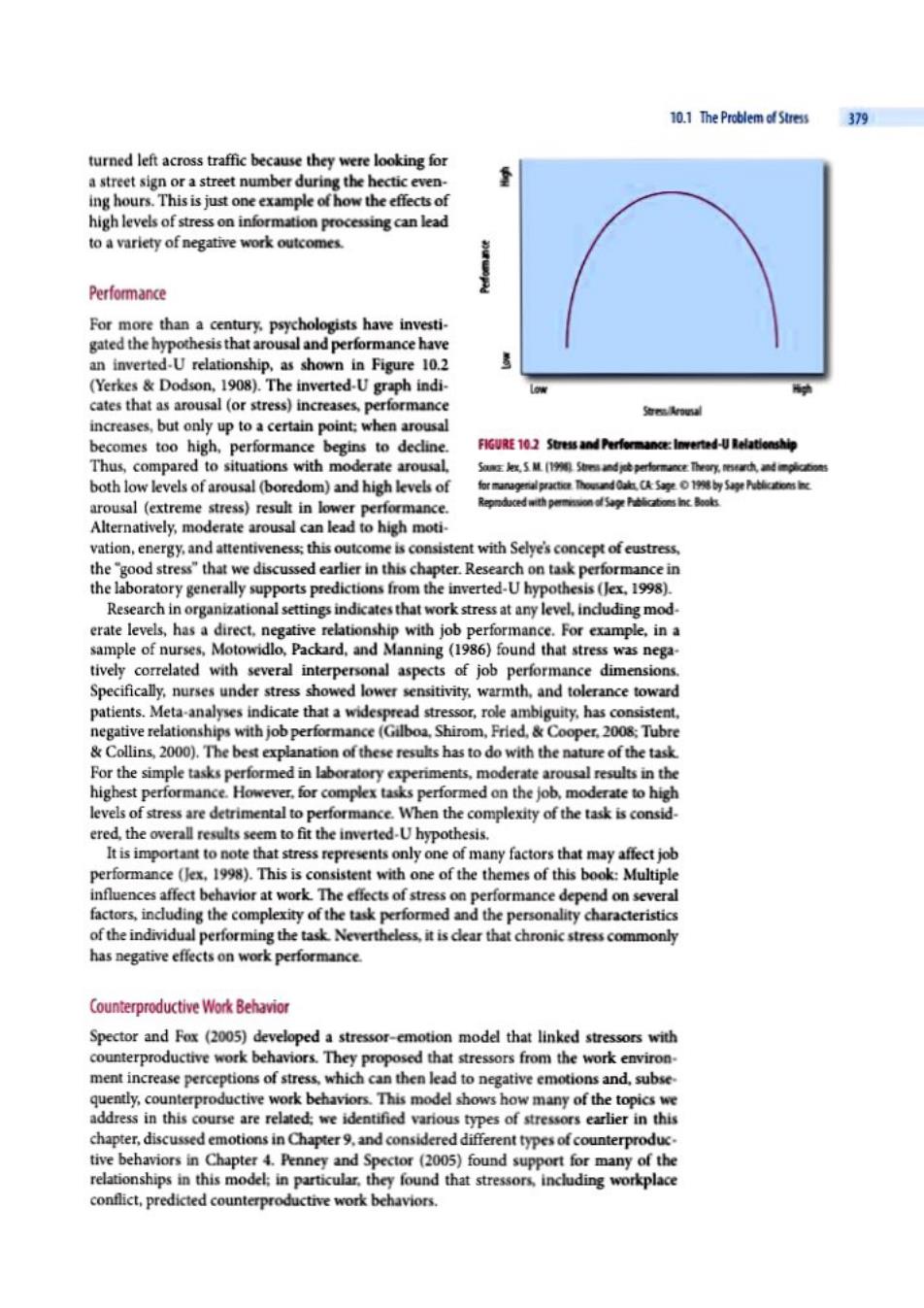
10.1 The Problem of Stress 379 turned left across traffic because they were looking for a street sign or a street number during the hectic even- ing hours.This is just one example of how the effects of high levels of stress on information processing can lead to a variety of negative work outcomes. Performance For more than a century.psychologists have investi- gated the hypothesis that arousal and performance have an inverted-U relationship,as shown in Figure 10.2 (Yerkes Dodson,1908).The inverted-U graph indi- cates that as arousal (or stress)increases,performance 知Aaud increases,but only up to a certain point:when arousal becomes too high,performance begins to decline. FIGURE 10.2 Stress and Performance:Inverted-U Relationship Thus,compared to situations with moderate arousal. SauE线5 M.(1991 Stms and je performance年#流dek6s both low levels of arousal (boredom)and high levels of rnag学ractie Thowand0t使5家o1%yS学tmx arousal (extreme stress)result in lower performance. Repmduced with permission l Sape hcatons inc Boalks Alternatively,moderate arousal can lead to high moti- vation,energy,and attentiveness;this outcome is consistent with Selye's concept of eustress. the 'good stress"that we discussed earlier in this chapter.Research on task performance in the laboratory generally supports predictions from the inverted-U hypothesis (Jex.1998). Research in organizational settings indicates that work stress at any level,induding mod. erate levels,has a direct,negative relationship with job performance.For example,in a sample of nurses,Motowidlo,Packard,and Manning (1986)found that stress was nega- tively correlated with several interpersonal aspects of job performance dimensions. Specifically,nurses under stress showed lower sensitivity.warmth,and tolerance toward patients.Meta-analyses indicate that a widespread stressor,role ambiguity,has consistent. negative relationships with job performance(Gilboa.Shirom,Fried,Cooper,2008:Tubre Collins,2000).The best explanation of these results has to do with the nature of the task. For the simple tasks performed in laboratory experiments,moderate arousal results in the highest performance.However,for complex tasks performed on the job,moderate to high levels of stress are detrimental to performance.When the complexity of the task is consid. ered,the overall results seem to fit the inverted-U hypothesis. It is important to note that stress represents only one of many factors that may affect job performance (Jex,1998).This is consistent with one of the themes of this book:Multiple influences affect behavior at work.The effects of stress on performance depend on several factors,incuding the complexity of the task performed and the personality characteristics of the individual performing the task.Nevertheless,it is dear that chronic stress commonly has negative effects on work performance. Counterproductive Work Behavior Spector and Fox (2005)developed a stressor-emotion model that linked stressors with counterproductive work behaviors.They proposed that stressors from the work environ. ment increase perceptions of stress,which can then lead to negative emotions and,subse. quently,counterproductive work behaviors.This model shows how many of the topics we address in this course are related:we identified various types of stressors earlier in this chapter,discussed emotions in Chapter 9.and considered different types of counterproduc. tive behaviors in Chapter 4.Penney and Spector (2005)found support for many of the relationships in this model:in particular,they found that stressors,including workplace conflict,predicted counterproductive work behaviors
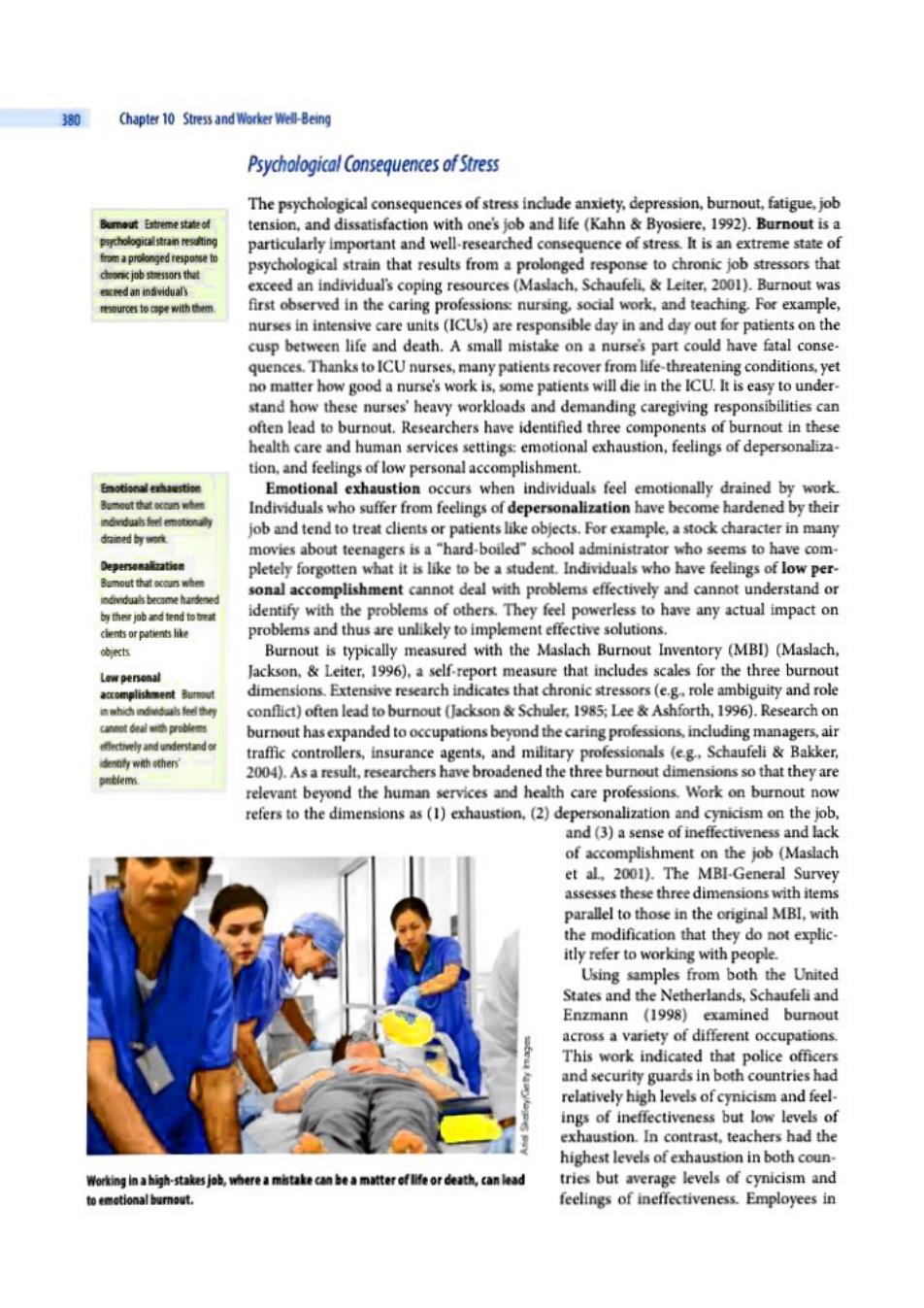
380 Chapter 10 Stress and Worker Well-Being Psychological Consequences of Stress The psychological consequences of stress include anxiety,depression,burnout,fatigue,job moft由eme state of tension,and dissatisfaction with one's job and life(Kahn Byosiere,1992).Burnout is a hologicalstrain传ng particularly important and well-researched consequence of stress.It is an extreme state of cheonic job stwssors thet psychological strain that results froma prolonged response to chronic job stressors that weda动nviduals exceed an individual's coping resources (Maslach,Schaufeli.Leiter,2001).Burnout was to cge with first observed in the caring professions:nursing.social work,and teaching.For example, nurses in intensive care units(ICUs)are responsible day in and day out for patients on the cusp between life and death.A small mistake on a nurse's part could have fatal conse- quences.Thanks to ICU nurses,many patients recover from life-threatening conditions,yet no matter how good a nurse's work is,some patients will die in the ICU.It is easy to under- stand how these nurses'heavy workloads and demanding caregiving responsibilities can often lead to burnout.Researchers have identified three components of burnout in these health care and human services settings:emotional exhaustion,feelings of depersonaliza- tion,and feelings of low personal accomplishment. Emotional exhaustion occurs when individuals feel emotionally drained by work. 8 mout that sccun wher Individuals who suffer from feelings of depersonalization have become hardened by their mt job and tend to treat clients or patients like objects.For example,a stock character in many 女md与A movies about teenagers is a "hard-boiled"school administrator who seems to have com- Depersonaliratien pletely forgotten what it is like to be a student.Individuals who have feelings of low per- mout that sccurs whes sonal accomplishment cannot deal with problems effectively and cannot understand or ndividuals becime hardened 年的e图b and tend物舰满 identify with the problems of others.They feel powerless to have any actual impact on clents or p时bentslike problems and thus are unlikely to implement effective solutions. 本 Burnout is typically measured with the Maslach Burnout Inventory (MBI)(Maslach, Lew personal Jackson,Leiter,1996),a self-report measure that includes scales for the three burnout a红omplishment Bureout dimensions.Extensive research indicates that chronic stressors (e.g.role ambiguity and role 施which indnduais feel中n conflict)often lead to burnout (Jackson Schuler,1985;Lee Ashforth,1996).Research on burnout has expanded to occupations beyond the caring professions,including managers,air ectvely and understand or traffic controllers,insurance agents,and military professionals (eg.Schaufeli Bakker, 女n的with cther行 2004).As a result,researchers have broadened the three burnout dimensions so that they are relevant beyond the human services and health care professions.Work on burnout now refers to the dimensions as (1)exhaustion,(2)depersonalization and cynicism on the job, and (3)a sense of ineffectiveness and lack of accomplishment on the job (Maslach et al,2001).The MBI-General Survey assesses these three dimensions with items parallel to those in the original MBI,with the modification that they do not explic- itly refer to working with people. Using samples from both the United States and the Netherlands,Schaufeli and Enzmann (1998)examined burnout across a variety of different occupations. This work indicated that police officers and security guards in both countries had relatively high levels of cynicism and feel- ings of ineffectiveness but low levels of exhaustion.In contrast,teachers had the highest levels of exhaustion in both coun- Working in ahigh-stakes job,where a mistake can be a matter of life or death,can lead tries but average levels of cynicism and to emetional burnout. feelings of ineffectiveness.Employees in
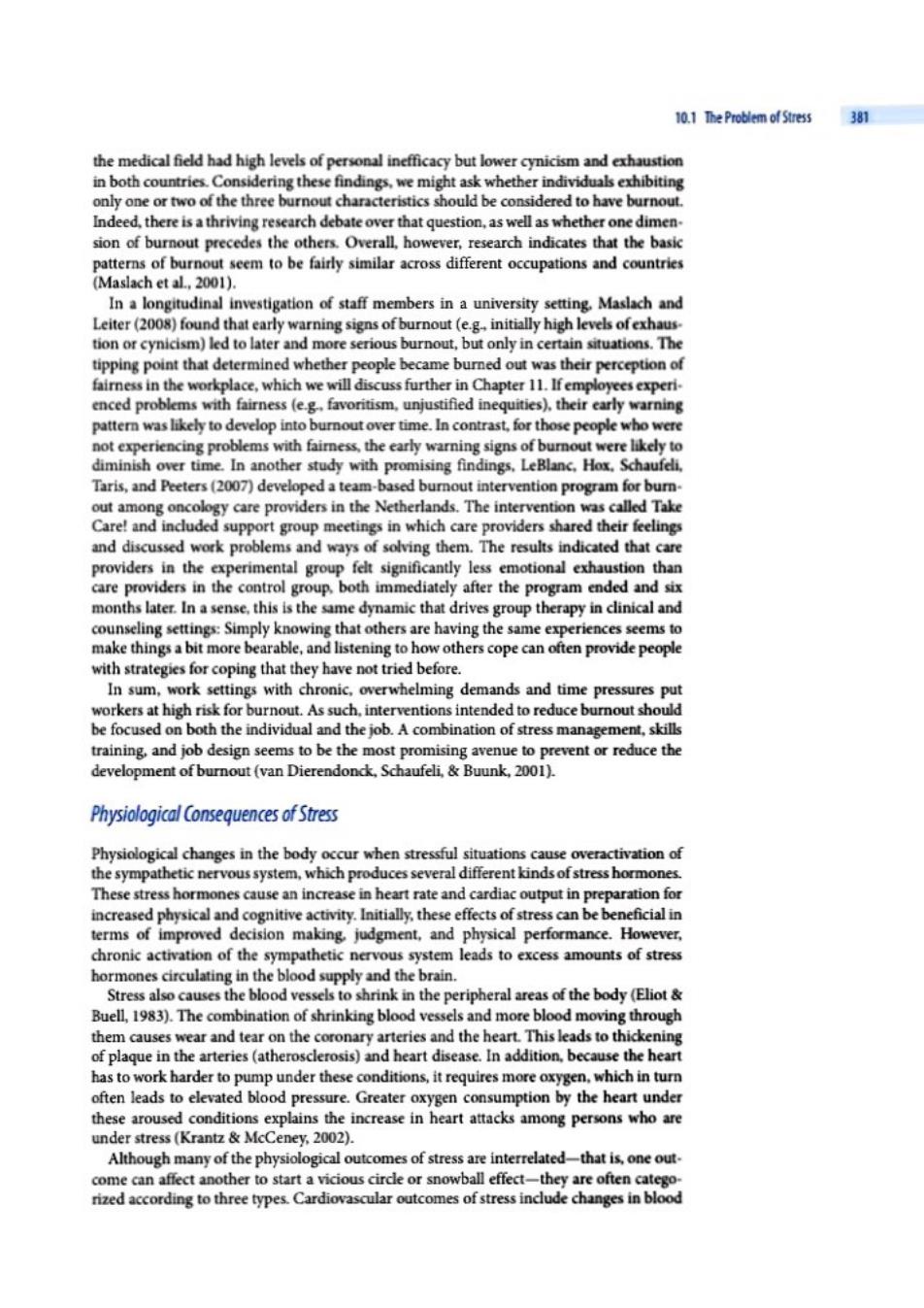
10.1 The Problem of Stress 381 the medical field had high levels of personal inefficacy but lower cynicism and exhaustion in both countries.Considering these findings,we might ask whether individuals exhibiting only one or two of the three burnout characteristics should be considered to have burnout. Indeed,there is a thriving research debate over that question,as well as whether one dimen. sion of burnout precedes the others.Overall,however,research indicates that the basic patterns of burnout seem to be fairly similar across different occupations and countries (Maslach et al.,2001). In a longitudinal investigation of staff members in a university setting.Maslach and Leiter (2008)found that early warning signs of burnout(e.g.initially high levels of exhaus- tion or cynicism)led to later and more serious burnout,but only in certain situations.The tipping point that determined whether people became burned out was their perception of fairness in the workplace,which we will discuss further in Chapter 11.If employees experi- enced problems with fairness (e.g.favoritism.unjustified inequities).their early warning patter was likely to develop into burnout over time.In contrast,for those people who were not experiencing problems with faimess,the early warning signs of burout were likely to diminish over time.In another study with promising findings.LeBlanc,Hox.Schaufei. Taris,and Peeters(2007)developed a team-based burout intervention program for burn. out among oncology care providers in the Netherlands.The intervention was called Take Care!and induded support group meetings in which care providers shared their feelings and discussed work problems and ways of solving them.The results indicated that care providers in the experimental group felt significantly less emotional exhaustion than care providers in the control group,both immediately after the program ended and six months later.In a sense.this is the same dynamic that drives group therapy in clinical and counseling settings:Simply knowing that others are having the same experiences seems to make things a bit more bearable,and listening to how others cope can often provide people with strategies for coping that they have not tried before. In sum,work settings with chronic,overwhelming demands and time pressures put workers at high risk for burnout.As such.interventions intended to reduce burnout should be focused on both the individual and the job.A combination of stress management,skills training,and job design seems to be the most promising avenue to prevent or reduce the development of burnout (van Dierendonck.Schaufeli,Buunk,2001). Physiological Consequences of Stress Physiological changes in the body occur when stressful situations cause overactivation of the sympathetic nervous system,which produces several different kinds ofstress hormones. These stress hormones cause an increase in heart rate and cardiac output in preparation for increased physical and cognitive activity.Initially,these effects of stress can be beneficial in terms of improved decision making judgment,and physical performance.However, chronic activation of the sympathetic nervous system leads to excess amounts of stress hormones circulating in the blood supply and the brain. Stress also causes the blood vessels to shrink in the peripheral areas of the body (Eliot Buell,1983).The combination of shrinking blood vessels and more blood moving through them causes wear and tear on the coronary arteries and the heart.This leads to thickening of plaque in the arteries(atherosclerosis)and heart disease.In addition,because the heart has to work harder to pump under these conditions,it requires more oxygen,which in turn often leads to elevated blood pressure.Greater oxygen consumption by the heart under these aroused conditions explains the increase in heart attacks among persons who are under stress(Krantz McCeney,2002). Although many of the physiological outcomes of stress are interrelated-that is,one out. come can affect another to start a vicious circle or snowball effect-they are often catego- rized according to three types.Cardiovascular outcomes of stress include changes in blood
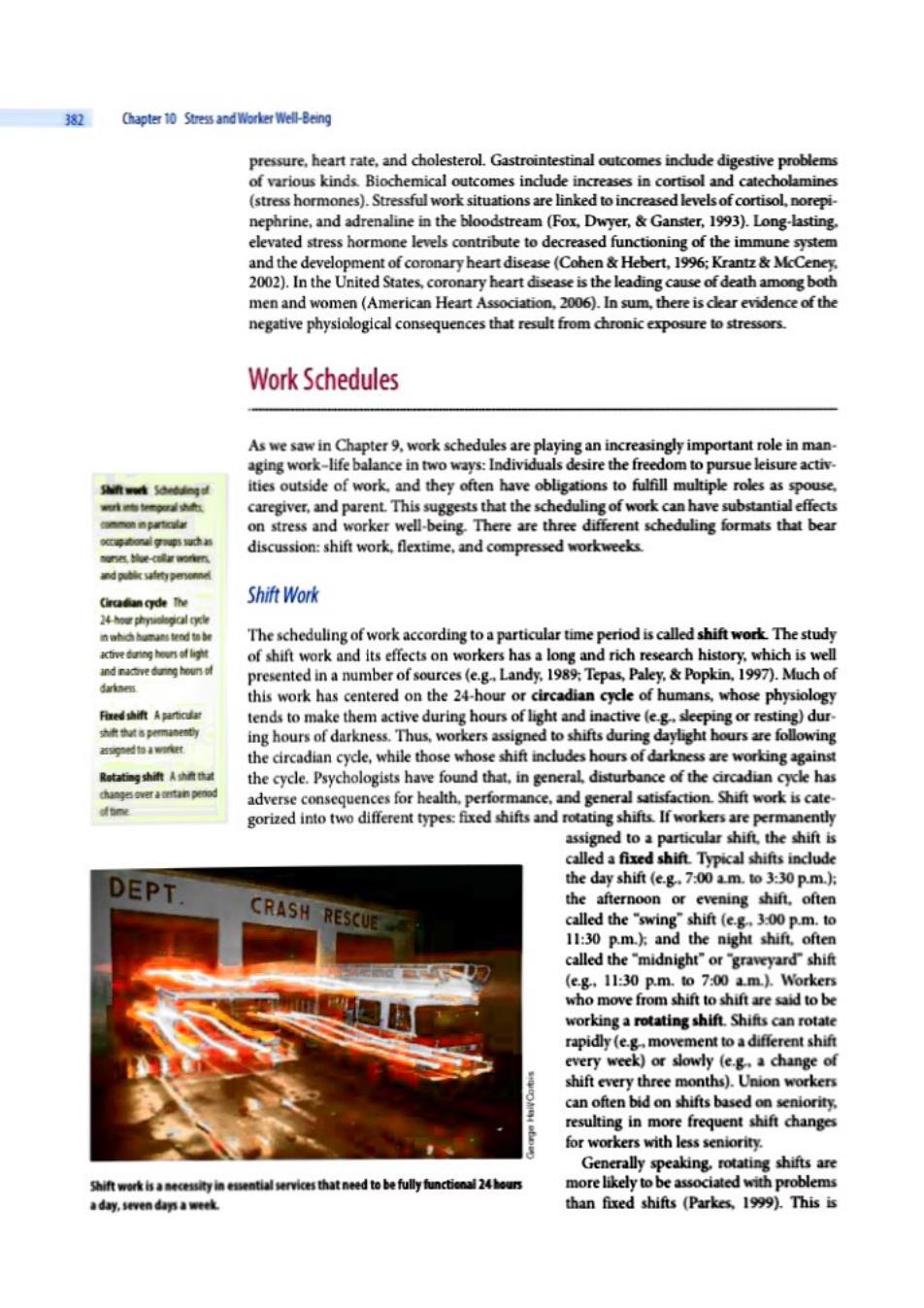
382 Chapter 10 Stress and Worker Well-Being pressure,heart rate,and cholesterol.Gastrointestinal outcomes indude digestive problems of various kinds.Biochemical outcomes indude increases in cortisol and catecholamines (stress hormones).Stressful work situations are linked to increased levels of cortisol,norepi- nephrine,and adrenaline in the bloodstream(Fox,Dwyer,Ganster,1993).Long-lasting. elevated stress hormone levels contribute to decreased functioning of the immune system and the development of coronary heart disease(Cohen Hebert,1996;Krantz&McCeney. 2002).In the United States,coronary heart disease is the leading cause of death among both men and women (American Heart Association,2006).In sum,there is clear evidence of the negative physiological consequences that result from chronic exposure to stressors. Work Schedules As we saw in Chapter 9,work schedules are playing an increasingly important role in man- aging work-life balance in two ways:Individuals desire the freedom to pursue leisure activ. ities outside of work,and they often have obligations to fulfill multiple roles as spouse. caregiver,and parent.This suggests that the scheduling of work can have substantial effects mmon n partcdlat on stress and worker well-being.There are three different scheduling formats that bear 红诗0g的中n discussion:shift work,flextime,and compressed workweeks ae-Ggw指 dpkw构n6 (rcadan epde The Shift Work 24he南cye in whidh humans tend te be The scheduling of work according to a particular time period is called shift work The study active dng houn时l of shift work and its effects on workers has a long and rich research history.which is well and nactive during hours时 presented in a number of sources (e.g.Landy,1989:Tepas,Paley,Popkin.1997).Much of darkness this work has centered on the 24-hour or circadian cycle of humans,whose physiology Fired shift Aparticu知 tends to make them active during hours of light and inactive (e-g.sleeping or resting)dur 浦春e向 ing hours of darkness.Thus,workers assigned to shifts during daylight hours are following 若可d物a时 the circadian cycle,while those whose shift includes hours of darkness are working against Rath通Ah油 the cycle.Psychologists have found that.in general,disturbance of the circadian cycle has changes over penod adverse consequences for health,performance,and general satisfaction.Shift work is cate- gorized into two different types:fixed shifts and rotating shifts If workers are permanently assigned to a particular shift.the shift is called a fixed shift.Typical shifts include DEPT the day shift (e.g.7:00 am.to 3:30 p.m.): CRASH RESCUE the afternoon or evening shift.often called the "swing"shift (e.g.3:00 p.m.to 11:30 p.m.):and the night shift.often called the"midnight"orgraveyard"shift (e-g.11:30 p.m.to 7:00 a.m.).Workers who move from shift to shift are said to be working a rotating shift.Shifts can rotate rapidly (e.g.movement to a different shift every week)or slowly (e.g.a change of shift every three months).Union workers can often bid on shifts based on seniority. resulting in more frequent shift changes for workers with less seniority. Generally speaking.rotating shifts are Shiftwerk isaecessity in esential services that need to be fully functiona 24hours more likely to be associated with problems a day.seven days a week. than fixed shifts (Parkes,1999).This is
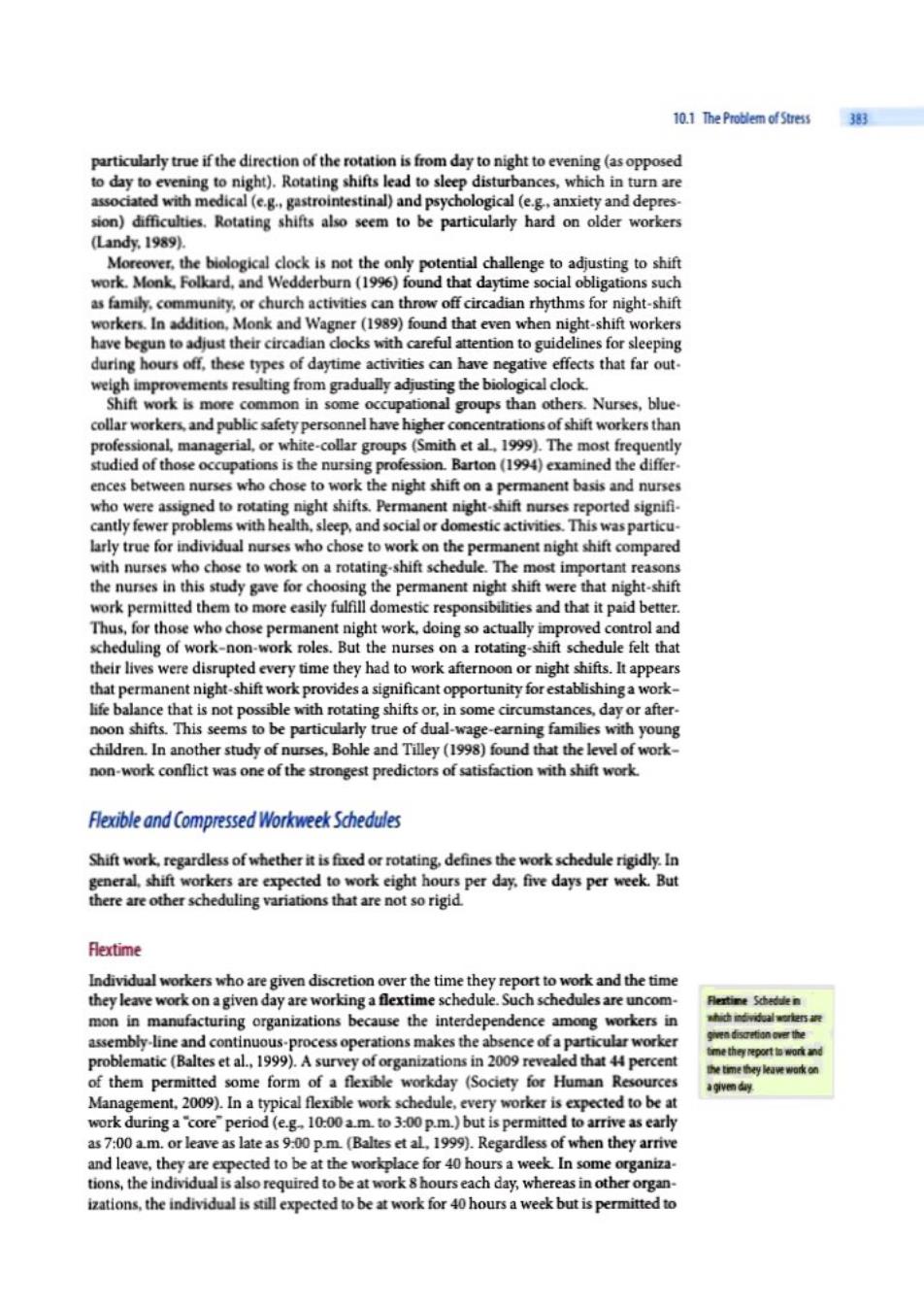
10.1 The Problem of Stress 383 particularly true if the direction of the rotation is from day to night to evening (as opposed to day to evening to night).Rotating shifts lead to sleep disturbances,which in turn are associated with medical (e.g.,gastrointestinal)and psychological (e.g,anxiety and depres- sion)difficulties.Rotating shifts also seem to be particularly hard on older workers andy.1989). Moreover,the biological clock is not the only potential challenge to adjusting to shift work.Monk.Folkard,and Wedderburn (1996)found that daytime social obligations such as family,community,or church activities can throw off circadian rhythms for night-shift workers.In addition.Monk and Wagner (1989)found that even when night-shift workers have begun to adjust their circadian docks with careful attention to guidelines for sleeping during hours off,these types of daytime activities can have negative effects that far out. weigh improvements resulting from gradually adjusting the biological clock. Shift work is more common in some occupational groups than others.Nurses,blue. collar workers,and public safety personnel have higher concentrations of shift workers than professional,managerial,or white-collar groups (Smith et al,1999).The most frequently studied of those occupations is the nursing profession.Barton(1994)examined the differ. ences between nurses who chose to work the night shift on a permanent basis and nurses who were assigned to rotating night shifts.Permanent night-shift nurses reported signifi. cantly fewer problems with health,sleep,and social or domestic activities.This was particu- larly true for individual nurses who chose to work on the permanent night shift compared with nurses who chose to work on a rotating-shift schedule.The most important reasons the nurses in this study gave for choosing the permanent night shift were that night-shift work permitted them to more easily fulfill domestic responsibilities and that it paid better. Thus,for those who chose permanent night work.doing so actually improved control and scheduling of work-non-work roles.But the nurses on a rotating-shift schedule felt that their lives were disrupted every time they had to work afternoon or night shifts.It appears that permanent night-shift work provides a significant opportunity for establishing a work- life balance that is not possible with rotating shifts or,in some circumstances,day or after. noon shifts.This seems to be particularly true of dual-wage-earning families with young children.In another study of nurses,Bohle and Tilley(1998)found that the level of work- non-work conflict was one of the strongest predictors of satisfaction with shift work. Flexible and Compressed Workweek Schedules Shift work.regardless of whether it is fixed or rotating.defines the work schedule rigidly.In general,shift workers are expected to work eight hours per day.five days per week.But there are other scheduling variations that are not so rigid. Rextime Individual workers who are given discretion over the time they report to work and the time they leave work on a given day are working a flextime schedule.Such schedules are uncom- mon in manufacturing organizations because the interdependence among workers in h水a打探 assembly-line and continuous-process operations makes the absence of a particular worker given discretion over the meh与port to work and problematic (Baltes et al.,1999).A survey of organizations in 2009 revealed that 44 percent he time they leave work o的 of them permitted some form of a flexible workday (Society for Human Resources Management,2009).In a typical flexible work schedule,every worker is expected to be at work during a core"period (e.g.10:00 a.m.to 3.00 p.m.)but is permitted to arrive as early as 7:00 am.or leave as late as 9.00 p.m.(Baltes et al,1999).Regardless of when they arrive and leave,they are expected to be at the workplace for 40 hours a week.In some organiza- tions,the individual is also required to be at work 8 hours each day,whereas in other organ- izations,the individual is still expected to be at work for 40 hours a week but is permitted to